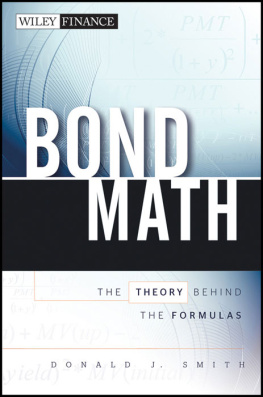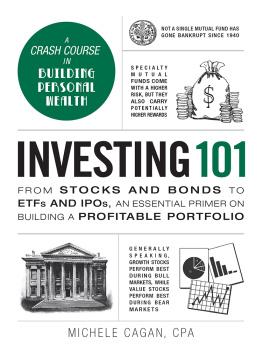ALL ABOUT BONDS, BOND MUTUAL FUNDS, AND BOND ETFs
OTHER TITLES IN THE "ALL ABOUT..." SERIES
All About Stock Market Strategies
by David Brown and Kassandra Bentley
All About Technical Analysis
by Constance Brown
All About Derivatives
by Michael Durbin
All About Investing
by Esm Faerber
All About Asset Allocation
by Richard A. Ferri
All About Index Funds
by Richard A. Ferri
All About Hedge Funds
by Robert A. Jaeger
All About Market Timing
by Les Masonson
All About Options, 3rd edition
by Thomas A. McCafferty
All About Dividend Investing
by Don Schreiber and Gary E. Stroik
All About Commodities
by Russell R. Wasendorf
All About Futures
by Russell R. Wasendorf
All About Stocks, 3rd edition
by Esm Faerber
All About Exchange Traded Funds
by Archie Richards, Jr.
ALL ABOUT BONDS, BOND MUTUAL FUNDS, AND BOND ETFs
Third Edition
ESM FAERBER


Copyright 2009 by Esm Faerber. All rights reserved. Except as permitted under the United States Copyright Act of 1976, no part of this publication may be reproduced or distributed in any form or by any means, or stored in a database or retrieval system, without the prior written permission of the publisher.
ISBN: 978-0-07-154428-3
MHID: 0-07-154428-3
The material in this eBook also appears in the print version of this title: ISBN: 978-0-07-154427-6, MHID: 0-07-154427-5.
All trademarks are trademarks of their respective owners. Rather than put a trademark symbol after every occurrence of a trademarked name, we use names in an editorial fashion only, and to the benefit of the trademark owner, with no intention of infringement of the trademark. Where such designations appear in this book, they have been printed with initial caps.
McGraw-Hill eBooks are available at special quantity discounts to use as premiums and sales promotions, or for use in corporate training programs. To contact a representative please visit the Contact Us page at www.mhprofessional.com.
This publication is designed to provide accurate and authoritative information in regard to the subject matter covered. It is sold with the understanding that the publisher is not engaged in rendering legal, accounting or other professional service. If legal advice or other expert assistance is required, the services of a competent professional person should be sought.
From a Declaration of Principles Jointly Adopted by a Committee of the American Bar
Association and a Committee of Publishers and Associations
All investing concepts, ideas, strategies, methods, etc. in this book are intended for educational purposes only. They are not meant to recommend or promote any investing strategy or philosophy. You are advised to consult a financial professional before investing.
TERMS OF USE
This is a copyrighted work and The McGraw-Hill Companies, Inc. ("McGraw-Hill") and its licensors reserve all rights in and to the work. Use of this work is subject to these terms. Except as permitted under the Copyright Act of 1976 and the right to store and retrieve one copy of the work, you may not decompile, disassemble, reverse engineer, reproduce, modify, create derivative works based upon, transmit, distribute, disseminate, sell, publish or sublicense the work or any part of it without McGraw-Hill's prior consent. You may use the work for your own noncommercial and personal use; any other use of the work is strictly prohibited. Your right to use the work may be terminated if you fail to comply with these terms.
THE WORK IS PROVIDED "AS IS." McGRAW-HILL AND ITS LICENSORS MAKE NO GUARANTEES OR WARRANTIES AS TO THE ACCURACY, ADEQUACY OR COMPLETENESS OF OR RESULTS TO BE OBTAINED FROM USING THE WORK, INCLUDING ANY INFORMATION THAT CAN BE ACCESSED THROUGH THE WORK VIA HYPERLINK OR OTHERWISE, AND EXPRESSLY DISCLAIM ANY WARRANTY, EXPRESS OR IMPLIED, INCLUDING BUT NOT LIMITED TO IMPLIED WARRANTIES OF MERCHANTABILITY OR FITNESS FOR A PARTICULAR PURPOSE. McGraw-Hill and its licensors do not warrant or guarantee that the functions contained in the work will meet your requirements or that its operation will be uninterrupted or error free. Neither McGraw-Hill nor its licensors shall be liable to you or anyone else for any inaccuracy, error or omission, regardless of cause, in the work or for any damages resulting therefrom. McGraw-Hill has no responsibility for the content of any information accessed through the work. Under no circumstances shall McGraw-Hill and/or its licensors be liable for any indirect, incidental, special, punitive, consequential or similar damages that result from the use of or inability to use the work, even if any of them has been advised of the possibility of such damages. This limitation of liability shall apply to any claim or cause whatsoever whether such claim or cause arises in contract, tort or otherwise.
CONTENTS
Chapter 1
What Bonds Can Do for You and Why You Should Consider Investing in Them |
Chapter 2
Characteristics of Bonds |
Chapter 3
Risks of Bonds |
Chapter 4
Yield and Price |
Chapter 5
Duration and Convexity |
Chapter 6
The Economy and the Bond Markets |
Chapter 7
Money Market Securities |
Chapter 8
Treasury Securities |
Chapter 9
Government Agency and Pass-Through Securities |
Chapter 10
Corporate Bonds |
Chapter 11
Municipal Bonds |
Chapter 12
Convertible Bonds |
Chapter 13
Zero Coupon Bonds and Zero Coupon Mutual Funds |
Chapter 14
International and Emerging Market Debt |
Chapter 15
Closed-End Funds |
Chapter 16
Portfolio Management and Evaluation |
PREFACE
This third edition includes information to assist bond investors to become more knowledgeable about their investments. Among the many changes to this edition are new chapters on foreign and emerging market debt, how to use duration and convexity concepts, and the inclusion of investing in bond exchange traded funds. Each chapter includes many new sections to provide both beginning and sophisticated bond investors with the tools to make more informed bond investments. Bond exchange traded funds are compared with bond mutual funds and investing in individual bonds.
The early chapters present information on the characteristics of bonds with the purpose of providing readers with an understanding of the workings of a bond, and their performance with regard to risk and return. The following chapters present the different types of bonds (Treasuries, government agency bonds, GNMA, FNMA, collateralized mortgage obligations, municipal bonds, corporate bonds, convertible bonds, zero coupon bonds, and foreign bonds) along with a comparison of the corresponding mutual funds and bond exchange traded funds. These chapters provide readers with the information to make their choices as to whether to invest in individual bonds, or bond mutual funds, or bond exchange traded funds. The last chapter provides the information to manage a bond portfolio.
Next page








